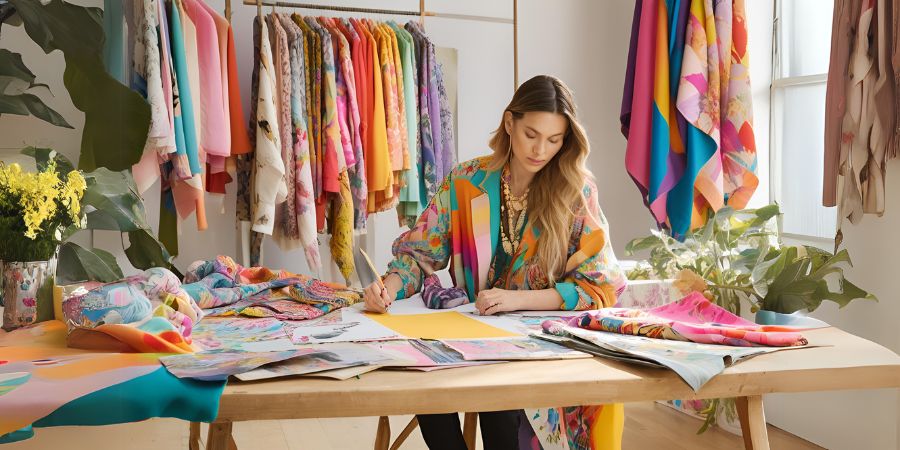Fashion design is a dynamic and creative career that combines artistic expression with technical skill. For those with a passion for creating beautiful and functional garments, the life of a fashion designer can be both fulfilling and challenging. This article delves into the various aspects of a fashion designer’s life, exploring their daily tasks, the skills they need, and the paths they can take to build a successful career.
What Does a Fashion Designer Do?
1. Designing Clothes and Accessories
At its core, a fashion designer’s job is to create clothing and accessories that meet both aesthetic and functional needs. This involves sketching designs, selecting fabrics, and working on prototypes. Designers often draw inspiration from current trends, historical styles, and personal creativity to produce unique collections.
2. Conducting Market Research
Understanding market trends is essential for a fashion designer. They must stay updated on consumer preferences, seasonal trends, and competitive products. Many designers attend fashion shows, analyze social media trends, and consult with retailers to stay ahead in the fast-paced industry.
3. Collaborating with Teams
Fashion designers rarely work in isolation. They collaborate with pattern makers, seamstresses, marketers, and buyers to bring their vision to life. Effective communication and teamwork are critical for ensuring that designs are executed flawlessly.
4. Overseeing Production
Once a design is finalized, fashion designers supervise the production process. This includes ensuring that garments meet quality standards and are manufactured within budget constraints. Some designers may also work closely with factories to oversee large-scale production.
Skills Needed to Succeed as a Fashion Designer
1. Creativity and Artistic Ability
A strong sense of creativity is the foundation of any fashion designer’s success. The ability to visualize new concepts and bring them to life through sketches and designs is paramount.
2. Technical Skills
Fashion designers need to master technical skills like sewing, pattern-making, and using computer-aided design (CAD) software. These skills help them turn abstract ideas into tangible products.
3. Business Acumen
Understanding the business side of fashion is equally important. Designers need knowledge of marketing, sales, and financial planning to manage their careers or run their own brands effectively.
4. Attention to Detail
Precision is vital in fashion design. From fabric selection to stitching details, every element contributes to the final product’s success.
5. Resilience and Adaptability
The fashion industry is highly competitive and constantly evolving. Successful designers must be resilient and adaptable to keep up with changes and overcome setbacks.
A Day in the Life of a Fashion Designer
1. Morning: Planning and Designing
Most fashion designers start their day by sketching ideas or reviewing ongoing projects. They might also spend time researching trends, sourcing materials, or planning upcoming collections.
2. Afternoon: Meetings and Collaboration
Afternoons are often dedicated to meetings with clients, suppliers, or team members. Designers may discuss project updates, review prototypes, or finalize details for production.
3. Evening: Events and Networking
Fashion designers often attend industry events, fashion shows, or networking gatherings in the evening. These opportunities allow them to showcase their work, build connections, and stay inspired.
Career Paths in Fashion Design
1. Haute Couture
Designers specializing in haute couture create custom-made garments for private clients. This prestigious field emphasizes luxury, craftsmanship, and exclusivity.
2. Ready-to-Wear
Ready-to-wear designers create garments that are mass-produced and sold in stores. This path focuses on blending style with practicality for a wider audience.
3. Costume Design
Some fashion designers work in the entertainment industry, designing costumes for movies, theater, or television. This field requires an understanding of character development and historical styles.
4. Sustainable Fashion
As sustainability becomes a priority, many designers are focusing on eco-friendly materials and ethical production practices. This niche is gaining popularity among conscious consumers.
5. Freelance Design
Freelance fashion designers work independently, offering their services to multiple clients. This path offers flexibility but requires strong self-discipline and marketing skills.
Challenges Faced by Fashion Designers
1. Intense Competition
The fashion industry is highly competitive, with thousands of designers vying for recognition. Building a unique identity and standing out is a significant challenge.
2. Long Hours
Fashion design often involves long hours, especially during peak seasons or before fashion shows. Deadlines can be demanding, requiring designers to work under pressure.
3. Financial Uncertainty
For independent designers, managing finances can be a struggle, especially in the early stages of their careers. Securing funding or attracting investors is often a hurdle.
4. Balancing Creativity with Practicality
Designers must strike a balance between their creative vision and the practical aspects of production and market demand. This requires flexibility and strategic thinking.
Rewards of Being a Fashion Designer
1. Creative Fulfillment
For those with a passion for fashion, designing garments is a deeply satisfying creative outlet. Turning ideas into reality brings immense joy and pride.
2. Global Recognition
Successful fashion designers gain recognition on a global scale. Their work is showcased in magazines, on runways, and worn by celebrities, offering a sense of accomplishment.
3. Opportunities for Travel
The fashion industry often involves travel to fashion weeks, sourcing trips, and international events. Designers get to explore new cultures and draw inspiration fro.m around the world.
4. Influence on Trends
Fashion designers play a crucial role in shaping trends and influencing consumer behavior. They have the power to set the tone for future styles.
Tips for Aspiring Fashion Designers
1. Build a Strong Portfolio
A well-curated portfolio showcasing your best work is essential for impressing employers or clients. Include a variety of styles to demonstrate versatility.
2. Gain Practical Experience
Internships and apprenticeships provide valuable hands-on experience and industry connections. Working with established designers can be a stepping stone to a successful career.
3. Network Actively
Building relationships within the fashion industry is key to career growth. Attend events, join professional organizations, and connect with mentors.
4. Stay Updated on Trends
Fashion is ever-changing, so staying informed about the latest trends and technologies is crucial. Subscribe to industry publications and follow influential designers for inspiration.
5. Pursue Continuous Learning
Consider enrolling in fashion design courses or workshops to refine your skills. Learning new techniques and tools will keep you ahead in the competitive industry.
FAQs
What is the life of a fashion designer?
The life of a fashion designer revolves around creativity, innovation, and collaboration. Designers work on creating unique clothing and accessories, conduct market research to stay ahead of trends, and manage production processes. Their days involve balancing creative projects with business demands, attending events, and staying updated on industry developments.
What do fashion designers do all day?
Fashion designers spend their days sketching designs, selecting fabrics, and working on prototypes. They conduct meetings with clients and teams, oversee production, and attend fashion events. A significant part of their day is dedicated to research, ensuring their creations align with market trends and consumer needs.
Is a fashion designer a good career?
Yes, fashion design is a rewarding career for those passionate about creativity and style. It offers opportunities for personal expression, global recognition, and the chance to influence trends. While the industry is competitive, it can be incredibly fulfilling for dedicated individuals who enjoy artistic and dynamic work.
What does a fashion designer do day to day?
Day-to-day tasks for fashion designers include sketching new ideas, meeting with clients, sourcing materials, and collaborating with team members. They also supervise production, ensure quality standards, and participate in marketing or promotional activities. Networking and attending fashion shows are also common daily activities.
What are 5 things fashion designers do?
- Sketching and conceptualizing new designs.
- Selecting fabrics and materials for collections.
- Overseeing garment production and ensuring quality.
- Conducting market research to understand trends.
- Collaborating with teams, clients, and suppliers.
What is fashion in daily life?
Fashion in daily life reflects personal style and cultural influences. It’s how individuals express themselves through clothing and accessories, balancing functionality with aesthetics. Daily fashion choices are shaped by trends, seasons, and individual preferences, showcasing the creativity and diversity of personal expression.
Conclusion
The life of a fashion designer is a blend of creativity, hard work, and perseverance. While the journey is filled with challenges, the rewards of seeing your designs come to life and influencing the world of fashion make it worthwhile. Whether you’re drawn to haute couture, ready-to-wear, or sustainable fashion, the possibilities are endless for those willing to dedicate themselves to this vibrant industry.


